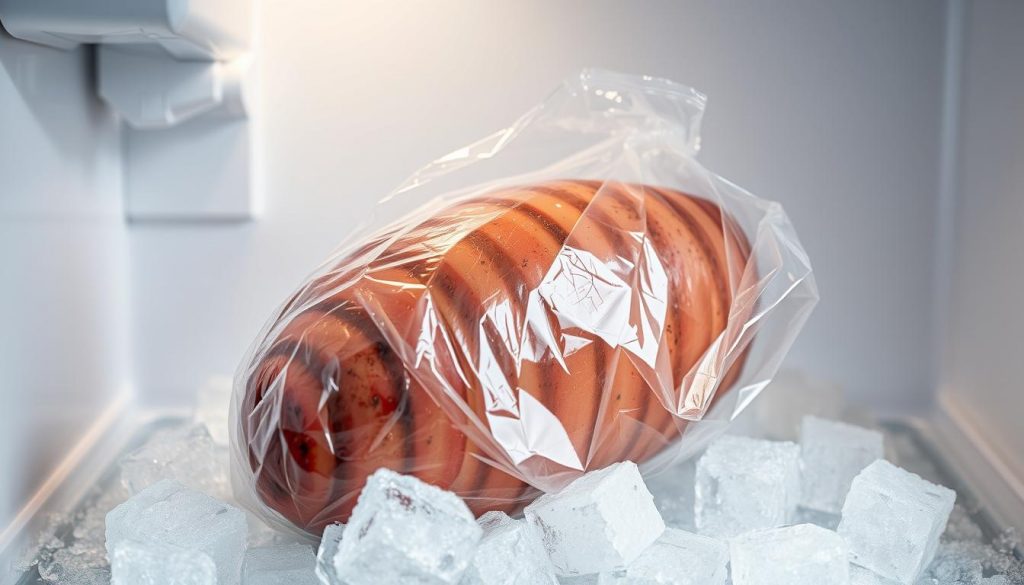We’re exploring how to keep cooked gammon fresh. If you’re curious about storing your ham, you’re in the right spot. This guide will cover storage tips and leftover ideas.
Whether you love cooking or just want to enjoy your holiday ham, knowing its fridge life is key. We’ll show you how to keep your gammon safe and tasty. This way, you can enjoy every bite.
Key Takeaways
- Proper storage extends cooked gammon shelf life
- Refrigeration temperature affects ham longevity
- Signs of spoilage in stored gammon
- Freezing methods for long-term storage
- Safe reheating techniques for leftover gammon
- Creative ways to use refrigerated gammon
Understanding Gammon: A Brief Overview
Gammon is a favorite at many dinner tables. We’ll look at what makes it special, its health benefits, and how to cook it right.
What Makes Gammon Different from Regular Ham
Gammon and ham differ mainly in how they’re cured. Gammon is cured before cooking, while ham is cured after. This makes gammon taste and feel different.
Nutritional Value of Gammon
Gammon is a protein powerhouse. It’s full of B vitamins and minerals like selenium and zinc. A 3-ounce serving has:
- Protein: 22 grams
- Fat: 4 grams
- Calories: 123
Popular Cooking Methods for Gammon
Cooking gammon is fun and rewarding. Here are some top ways to do it:
- Boiling: Simmer in water or cider for moist meat
- Roasting: Bake in the oven for a crispy outside
- Slow cooking: Use a crockpot for tender, flavorful meat
Each method brings out different flavors in gammon. Try them all to find your favorite!
Proper Storage Techniques for Cooked Gammon
Storing cooked gammon right is key to keeping it tasty and safe. We’ll show you how to store it in the fridge to make it last longer.
Optimal Storage Temperature
For the best storage, keep your fridge at 40°F (4°C) or colder. This stops bacteria from growing and keeps the meat’s taste and texture. Use a fridge thermometer to check the temperature.
Best Storage Containers
Use airtight containers to keep the gammon fresh. Glass or BPA-free plastic containers are good choices. Make sure the container is clean and dry before you use it.
Wrapping Methods for Maximum Freshness
Wrap the cooked gammon in plastic wrap or aluminum foil before putting it in containers. This keeps moisture in and prevents other fridge smells from getting in. You can even double-wrap it for extra protection.
- Let the gammon cool to room temperature before storing
- Divide large pieces into smaller portions for quicker cooling
- Label containers with the date of storage
- Place stored gammon on the bottom shelf of the fridge to prevent drips onto other foods
By using these storage tips, you can enjoy your cooked gammon for days. Always check for spoilage before eating leftover meat.
How Long Does Cooked Gammon Last in the Fridge
It’s important to know how long cooked gammon lasts to keep it safe and tasty. We’ve found the best ways to store cooked gammon. This helps you enjoy it for longer.
The time cooked gammon lasts in the fridge depends on a few things. If you store it in airtight containers or wrap it well, it can last 3 to 4 days. This keeps it tasting great and safe to eat.
To keep gammon fresh longer, try these tips:
- Cool the gammon to room temperature before refrigerating
- Store in the coldest part of your fridge, typically around 40°F (4°C)
- Use shallow containers to allow for quicker cooling
- Consume within the recommended timeframe for best quality
Freezing is another way to keep gammon longer. Frozen gammon can last up to 3 months. Just thaw it in the fridge and eat it within 24 hours.
| Storage Method | Refrigerated Ham Duration | Optimal Quality |
|---|---|---|
| Refrigeration | 3-4 days | High |
| Freezing | Up to 3 months | Good |
By following these tips, you can enjoy your cooked gammon safely. And you’ll get to enjoy its delicious taste for days.
Signs of Spoilage in Stored Gammon
It’s important to know when gammon has gone bad. We’ll show you how to spot the signs. This way, your gammon stays fresh and safe to eat.
Visual Indicators
Fresh gammon looks pinkish-red. Look out for green, gray, or brown spots. These are signs it’s spoiled. Also, mold, which looks like fuzzy patches, is a bad sign.

Smell Changes
Your nose can tell if meat is fresh. Fresh gammon smells mild and slightly sweet. If it smells sour, rancid, or like ammonia, it’s bad.
Texture Modifications
Fresh gammon feels firm and moist. If it’s slimy, sticky, or too dry, it’s spoiled. It’s better to be safe than sorry.
| Indicator | Fresh Gammon | Spoiled Gammon |
|---|---|---|
| Color | Pinkish-red | Green, gray, or brown spots |
| Smell | Mild, slightly sweet | Sour, rancid, or ammonia-like |
| Texture | Firm and moist | Slimy, sticky, or excessively dry |
These signs are true for both raw and cooked gammon. Always choose safety and freshness to enjoy your meals without worry.
Tips for Extending Gammon Shelf Life
Learning to keep cooked ham fresh is a skill. It can save you money and cut down on waste. Here are some easy tips to help you enjoy your gammon for longer.
First, wrap your cooked gammon tightly in plastic wrap or aluminum foil. This keeps air out and moisture in. For extra protection, put the wrapped ham in an airtight container before you refrigerate it.
Keep your fridge at a steady 35°F to 40°F. This ideal temperature helps slow down bacteria and keeps the flavor good. Store your ham on the bottom shelf to avoid mixing with other foods.
Only take out what you plan to eat. This helps keep the temperature steady and prevents bacteria. Always use clean utensils when handling the ham to avoid contamination.
“Proper storage is key to enjoying your gammon for days after cooking. With these simple steps, you’ll savor every last bite!”
If you have a vacuum sealer, use it. It removes all air, making your ham last longer. If you’re freezing, cut the ham into smaller pieces for easier thawing and use later.
| Storage Method | Shelf Life | Best Practices |
|---|---|---|
| Refrigeration | 3-5 days | Wrap tightly, store at 35°F-40°F |
| Freezing | Up to 6 months | Vacuum seal, portion before freezing |
| Vacuum Sealed | 7-10 days | Keep refrigerated, use within 24 hours of opening |
By following these tips, your cooked gammon will stay fresh and delicious for a long time. Enjoy your perfectly preserved ham!
Freezing Cooked Gammon: A Comprehensive Guide
Freezing cooked ham is a great way to keep it fresh longer. We’ll show you how to freeze cooked gammon. This way, you can enjoy your leftovers for weeks.
Preparation for Freezing
Let the cooked ham cool down completely before freezing. Cut it into portions for easy thawing. Wrap each piece tightly in plastic wrap or foil to avoid freezer burn.
Proper Freezing Techniques
Put the wrapped portions in freezer-safe bags or containers. Remove air to prevent ice crystals. Label each package with the freezing date for easy tracking.

Thawing Methods
When you’re ready to eat your frozen gammon, thaw it safely. The fridge is the best place for thawing frozen meat. Put the gammon in the fridge 24 hours before you plan to eat it.
For faster thawing, submerge the sealed package in cold water. Change the water every 30 minutes.
| Thawing Method | Time Required | Safety Level |
|---|---|---|
| Refrigerator | 24 hours | High |
| Cold Water | 1-2 hours | Medium |
| Microwave | 5-10 minutes | Low |
By following these steps, you’ll learn how to freeze cooked ham well. Your gammon will stay tasty for future meals.
Safe Handling Practices for Leftover Gammon
Proper food safety is key when dealing with leftovers. We’ll show you how to keep your cooked gammon safe. Follow these steps to avoid foodborne illness and enjoy your leftovers without worry.
Always wash your hands before and after touching leftover gammon. This simple act helps a lot in stopping foodborne illness. Use different cutting boards and tools for raw and cooked meats to prevent contamination.
Keeping leftovers at the right temperature is important. Refrigerate your cooked gammon within two hours of cooking or serving. It should stay at 40°F (4°C) or below to slow down bacteria growth. Cool food quickly and evenly by using shallow containers.
| Storage Method | Maximum Storage Time | Temperature |
|---|---|---|
| Refrigeration | 3-4 days | 40°F (4°C) or below |
| Freezing | 1-2 months | 0°F (-18°C) or below |
When reheating, make sure the gammon gets to 165°F (74°C) to kill bacteria. Use a food thermometer to check. Don’t reheat leftovers more than once to avoid bacterial growth.
“When in doubt, throw it out. It’s better to be safe than sorry when it comes to food safety.”
By following these tips, you’ll learn how to handle leftovers safely. This way, your gammon will stay delicious and safe to eat.
Reheating Stored Gammon Safely
Reheating cooked ham or leftover gammon can be tricky. We need to ensure safe food temperatures while preserving flavor. Let’s explore the best methods for warming up your delicious leftovers.
Microwave Reheating Guidelines
The microwave offers quick results for reheating cooked ham. Place slices on a microwave-safe plate and cover with a damp paper towel. Heat in 30-second intervals, checking frequently to avoid overcooking. Aim for an internal temperature of 165°F (74°C) for food safety.
Oven Reheating Methods
For larger portions of leftover gammon, the oven works best. Preheat to 325°F (163°C). Wrap the ham in foil with a splash of broth or water to keep it moist. Heat for about 10 minutes per pound until it reaches the safe internal temperature.
Stovetop Warming Techniques
The stovetop method is ideal for thin slices. Use a non-stick pan over medium-low heat. Add a small amount of butter or oil, then lay the slices flat. Cook for 2-3 minutes on each side until thoroughly heated.
| Reheating Method | Time | Temperature |
|---|---|---|
| Microwave | 30-second intervals | 165°F (74°C) |
| Oven | 10 min/pound | 325°F (163°C) |
| Stovetop | 2-3 min/side | Medium-low heat |
Remember, regardless of the method, always check that your reheated gammon reaches safe food temperatures before serving. This ensures both safety and flavor in your leftover meals.
Creative Ways to Use Leftover Gammon
Leftover gammon recipes are a tasty way to use up cooked meat. We’ve found some fun ideas to turn your leftovers into yummy meals.
Quick Meal Ideas
Make a tasty gammon and potato hash for breakfast. Dice the leftover ham and fry it with potatoes. Then, top it with a fried egg.
For a quick dinner, toss cubed gammon into creamy pasta. Or add it to a warm soup.
Sandwich Combinations
Make your sandwiches better with leftover ham. Try a Monte Cristo with gammon and cheese between French toast. Or go for a Cuban sandwich with gammon, Swiss cheese, pickles, and mustard on crusty bread.
Salad Incorporations
Gammon makes salads better with protein and flavor. Add diced ham to a Cobb salad. Or mix it with pasta, veggies, and a light dressing for a pasta salad.
For a twist, put gammon in a Caesar salad instead of chicken.
- Gammon and pineapple skewers for a sweet and savory appetizer
- Stuffed bell peppers with gammon, rice, and cheese
- Gammon and vegetable frittata for a protein-packed breakfast
These ideas show how versatile leftover gammon is. By using up cooked meat, you’ll waste less food and enjoy tasty meals all week.
Food Safety Guidelines for Cooked Meats
Meat safety is very important when handling and storing cooked meats. It’s key to follow USDA guidelines to avoid foodborne illnesses. This also helps keep your leftovers fresh for longer.
The USDA says to store cooked meats at 40°F or below. This keeps bacteria from growing too fast. Always use clean utensils and wash your hands well before and after touching cooked meats.
Here’s a quick guide to safe storage times for cooked meats:
| Meat Type | Refrigerator (40°F or below) | Freezer (0°F or below) |
|---|---|---|
| Cooked Gammon | 3-4 days | 1-2 months |
| Cooked Poultry | 3-4 days | 4-6 months |
| Cooked Beef | 3-4 days | 2-3 months |
When reheating cooked meats, make sure they get to 165°F. This kills any bacteria. Use a food thermometer to check the temperature.
By following these food safety tips, we can enjoy our cooked meats safely. Always trust your senses. If something looks or smells off, it’s best to throw it away.
Conclusion
We’ve talked a lot about storing gammon. Keeping it fresh and safe is very important. Always store it in the fridge at the right temperature.
Use airtight containers to keep it fresh. This helps a lot.
Our food safety recap is very important. Watch for signs of spoilage like bad smells, colors, or textures. If you see any, throw it away.
Knowing how long cooked ham lasts is key. This helps you plan meals and avoid wasting food. You can enjoy your leftover gammon for several days.
Try it in sandwiches or salads. There are many ways to use it up before it goes bad.




